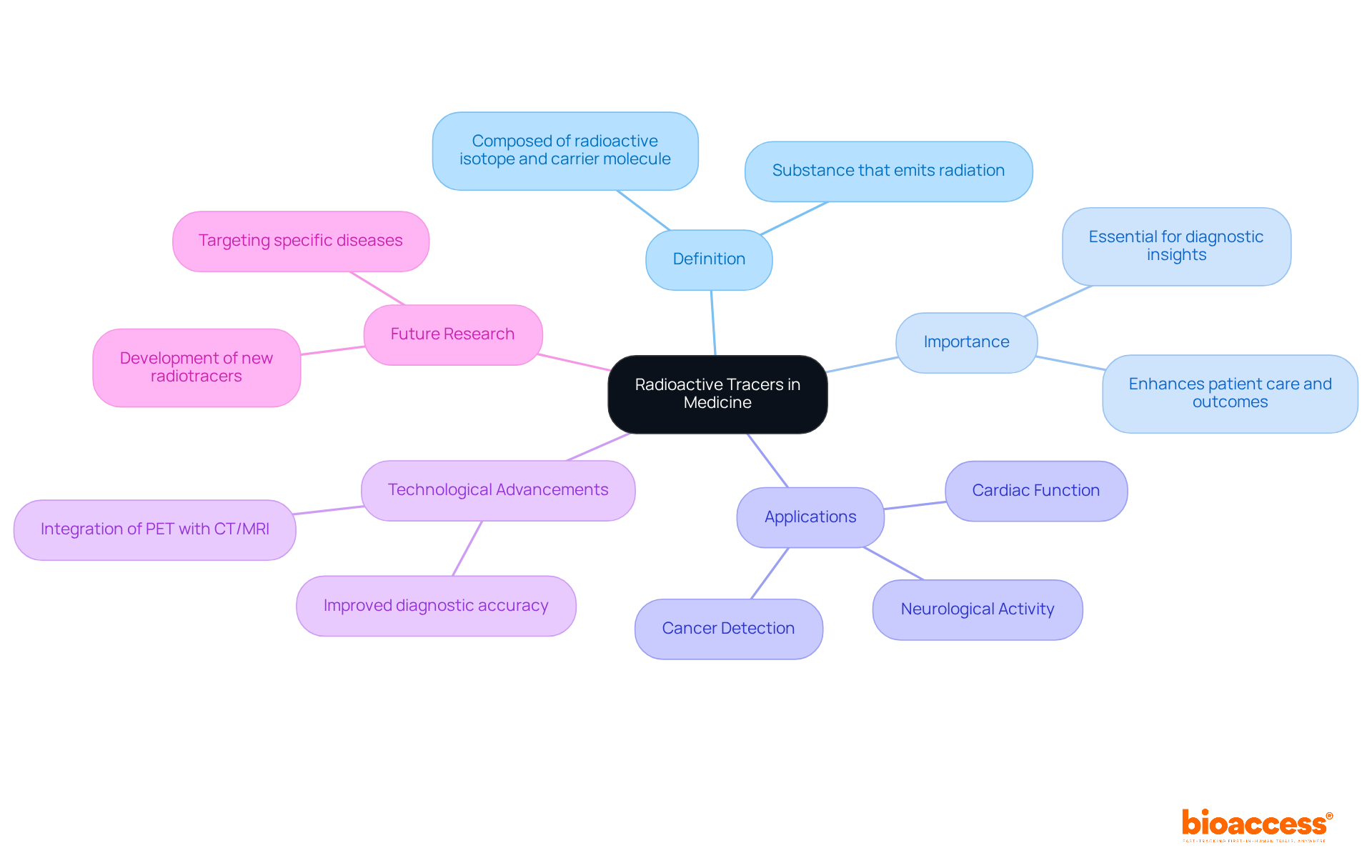


Radioactive tracers have become essential tools in modern medicine, fundamentally transforming diagnostic imaging and therapeutic practices. By leveraging the power of radiation, these substances offer critical insights into the body's physiological processes. This capability enables healthcare professionals to detect diseases such as cancer and evaluate organ functionality with remarkable precision. However, as the reliance on these advanced technologies increases, so do the challenges related to their production and safe application.
What are the implications of these developments for patient care? The medical community must navigate the complexities of radioactive tracers to optimize their benefits while mitigating risks. Understanding these dynamics is crucial for enhancing clinical research and improving patient outcomes.
A radioactive tracer in medicine, commonly referred to as a radiomarker, is a substance that emits radiation and plays a crucial role in medical imaging and therapy. These markers, typically composed of a radioactive isotope linked to a carrier molecule, are designed to target specific organs or tissues within the body. Their importance in modern medicine is evident, as a radioactive tracer in medicine provides essential diagnostic insights into physiological processes, enabling healthcare professionals to visualize and assess the functionality of various organs. For example, tracers are vital in identifying cancer, observing cardiac function, and assessing neurological activity, ultimately enhancing patient care and outcomes.
Recent advancements in the use of radioactive tracer in medicine technology have significantly improved diagnostic accuracy and therapeutic effectiveness. The integration of positron emission tomography (PET) with computed tomography (CT) or magnetic resonance imaging (MRI) has revolutionized diagnostic methods, offering detailed three-dimensional visuals that facilitate accurate diagnosis and treatment planning. Notably, statistics reveal that technetium-99m, which is the most commonly used radioactive tracer in medicine, accounts for approximately 80% of all nuclear medicine procedures, underscoring its critical role in patient diagnostics.
Moreover, ongoing research and development efforts are dedicated to creating new radiotracers that can target specific diseases more effectively. For instance, the application of fluorine-18 in PET imaging has demonstrated significant promise in oncology, allowing for the detection of tumors at earlier stages. As the field of nuclear medicine continues to evolve, the importance of radioactive substances in enhancing patient outcomes remains paramount.

The role of a radioactive tracer in medicine is pivotal in clinical research, produced through advanced methods such as cyclotron production, neutron activation, and generator systems. Cyclotrons are crucial for generating short-lived isotopes like Fluorine-18, essential for PET scans due to its rapid decay and superior visualization quality. Conversely, neutron activation transforms stable isotopes into radioactive forms by irradiating them within a nuclear reactor. Generator systems allow for the gradual extraction of isotopes from parent materials, ensuring a consistent supply over time.
The applications of these radioactive tracers in medicine are vast, covering both diagnostic assessments and targeted therapies. For instance, Technetium-99m, derived from Molybdenum-99, is a cornerstone of SPECT technology, widely used to evaluate blood circulation and organ performance across various clinical settings, accounting for 80% of nuclear medicine research. Similarly, Iodine-131 is vital for treating and visualizing thyroid disorders, showcasing the therapeutic potential of these isotopes.
Recent advancements in cyclotron technology have introduced innovative production techniques, significantly enhancing the efficiency and yield of radiotracers. This evolution is critical as the demand for precise diagnostic tools and targeted treatments continues to escalate. Understanding these production methods and their applications, particularly the role of radioactive tracer in medicine, is essential. As David Harris, President and CEO of Kinectrics, emphasizes, our capacity to scale production through innovation is key to meeting the growing demand for life-saving isotopes.

The use of a radioactive tracer in medicine is crucial in various medical visualization techniques, particularly in Positron Emission Tomography (PET) and Single Photon Emission Computed Tomography (SPECT). In PET scans, substances like Fluorodeoxyglucose (FDG) are utilized to visualize metabolic activity, which is vital for detecting tumors at their earliest stages. Conversely, SPECT scanning employs tracers such as Technetium-99m to evaluate blood flow and organ function. These advanced visualization methods provide real-time insights into physiological processes, facilitating precise diagnosis and effective treatment planning.
Moreover, the integration of a radioactive tracer in medicine into hybrid imaging systems, such as PET/CT, enhances diagnostic accuracy by combining anatomical and functional imaging. This synergy not only improves patient management but also addresses key challenges in the Medtech landscape. As clinical research continues to evolve, the collaboration between technology and healthcare professionals becomes increasingly important. By leveraging these innovative imaging techniques, we can significantly advance our understanding of complex medical conditions and improve patient outcomes.

The benefits of using a radioactive tracer in medicine are substantial. These non-invasive techniques facilitate the diagnosis of illnesses, enabling early identification and care that can significantly enhance patient outcomes. Moreover, the capacity to visualize physiological processes in real-time improves the accuracy of diagnoses and treatment plans.
However, it is essential to consider the limitations associated with their use. The application of nuclear materials entails exposure to radiation, which can pose risks, particularly for vulnerable populations. Additionally, the availability of specific markers may be limited due to production challenges or regulatory constraints.
Understanding both the benefits and limitations of radioactive tracers in medicine is crucial for healthcare professionals. This knowledge empowers them to make informed decisions regarding the appropriate use of these tools in patient care, ultimately leading to better health outcomes.

The exploration of radioactive tracers in medicine underscores their essential role in enhancing diagnostic capabilities and therapeutic interventions. These radiomarkers serve as indispensable tools, enabling healthcare professionals to visualize and assess organ functionality, which significantly impacts patient care and treatment outcomes.
This article delves into various aspects of radioactive tracers, including their production methods and applications in medical imaging techniques such as PET and SPECT. It also addresses the balance between their benefits and limitations. Key insights reveal how advancements in technology and ongoing research are paving the way for more effective and targeted applications, ensuring these tools evolve alongside medical needs.
Ultimately, grasping the significance of radioactive tracers in healthcare is crucial for both professionals and patients. As the field advances, embracing these innovations will not only improve diagnostic accuracy and treatment planning but also enhance overall patient outcomes. Engaging with the latest developments in radioactive tracer applications can lead to better-informed healthcare decisions and a promising future in medical diagnostics and therapy.
What is a radioactive tracer in medicine?
A radioactive tracer, also known as a radiomarker, is a substance that emits radiation and is used in medical imaging and therapy. It typically consists of a radioactive isotope linked to a carrier molecule that targets specific organs or tissues in the body.
Why are radioactive tracers important in medicine?
Radioactive tracers are crucial for providing diagnostic insights into physiological processes, allowing healthcare professionals to visualize and assess the functionality of various organs. They are vital for identifying conditions such as cancer, observing cardiac function, and assessing neurological activity, ultimately enhancing patient care and outcomes.
How have advancements in technology improved the use of radioactive tracers?
Recent technological advancements, particularly the integration of positron emission tomography (PET) with computed tomography (CT) or magnetic resonance imaging (MRI), have significantly improved diagnostic accuracy and therapeutic effectiveness by offering detailed three-dimensional visuals for accurate diagnosis and treatment planning.
What is the most commonly used radioactive tracer in medicine?
Technetium-99m is the most commonly used radioactive tracer in medicine, accounting for approximately 80% of all nuclear medicine procedures, highlighting its critical role in patient diagnostics.
What ongoing efforts are being made in the field of radioactive tracers?
Ongoing research and development efforts are focused on creating new radiotracers that can more effectively target specific diseases. For example, fluorine-18 is being applied in PET imaging and shows significant promise in oncology for detecting tumors at earlier stages.
How do radioactive tracers enhance patient outcomes?
By providing accurate diagnostic information and enabling the visualization of physiological processes, radioactive tracers enhance patient outcomes through better diagnosis, targeted treatment planning, and improved monitoring of diseases.